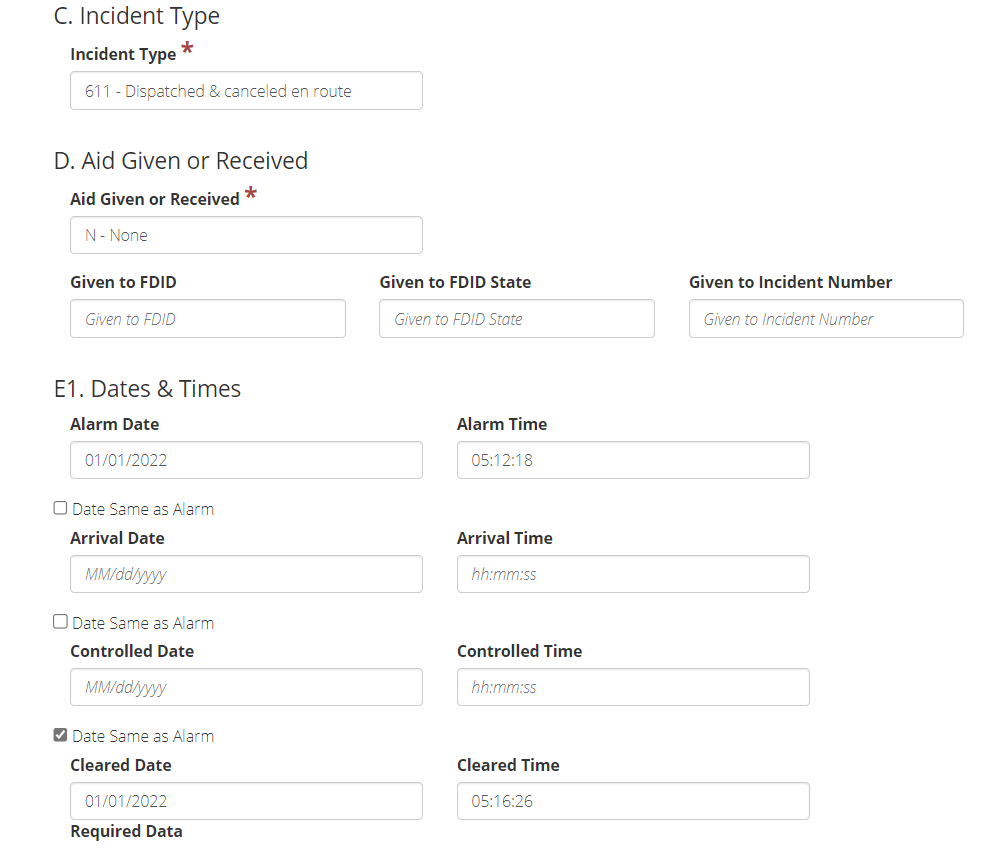Dispatched and Canceled en Route
Posted: June 19, 2023
- Find similar NFIRSGrams:
- Basic Module
- Coding
- Data Quality
This NFIRSGram explains how to correctly use the Incident Type Code 611 – Dispatched and canceled en route when writing a report in the National Fire Incident Reporting System (NFIRS).
This incident type should only be used when the fire department is dispatched to an incident but does not arrive on the scene because they were canceled prior to arrival. Fire departments who arrive on the scene should code the incident type to the actual situation found on the scene when they arrived and should not use 611.
Remember
It is not an NFIRS incident if:
- Your resources were not dispatched and did not leave the station.
- The fire department was not aware of the call.
- The fire department was aware of the call but did not have resources to respond.
While these situations are not reportable in NFIRS, it is recommended the fire department record them outside of NFIRS in a separate database.
What features must be present in a report of a canceled en route call?
- Incident Type must be 611 – Dispatched and canceled en route.
- Arrival Date/Time must be blank.
- Actions Taken must be 93 – Canceled en route.
- Aid Given or Received should be N – None.
If the fire department arrives at the scene, completes an action on scene, and/or gives or receives aid, then the incident type should not be canceled en route, and a different incident type code should be chosen.
Reminder: For Incident Type 611 – Dispatched and canceled en route calls, the casualty and property use fields are not required on the Basic Module.

Canceled en route calls should not have aid given or aid received present.
Aid given or received calls require the arrival of 2 or more fire departments on scene. A canceled en route call means a fire department does not arrive on the scene.
Scenario 1
A fire department is called to a building fire. Based on information provided by dispatch, the fire department requests mutual aid. When the first fire department arrives, it is determined that the situation no longer requires extra manpower, and the fire department cancels the mutual aid department before they arrive.
In this case, the first fire department would report the incident type code as what they found on scene when they arrived, a building fire (111). The aid given or received code would be N – None.
The second fire department would use 611 – Dispatched and canceled en route as the Incident Type Code, document 93 – Dispatched and canceled en route as Actions Taken, and they would leave the Incident Arrival Date/Time as blank. Likewise, the aid given or received code would be N – None.
Note: For those departments that want to document where they attempted to provide mutual aid despite being canceled en route, use the District field (Block E2 of the Basic Module). This is a local-defined code (3-character limit) that describes the district where the incident happened. The fire department can analyze how often they were canceled en route to other districts using the results from this field.

Apparatus and personnel can be dispatched and canceled en route, even if the fire department arrives on the scene to an incident.
The use of the Apparatus/Personnel Modules can show what resources were available, even though they never arrived on scene.
Scenario 2
A fire department is called to a building fire. Based on information provided by dispatch, the fire department sends an engine, a tanker/tender, a rescue vehicle and the fire marshal’s car. When the first apparatus, the engine, arrives, it is determined that the situation is a false alarm and no longer requires extra resources. The fire department cancels the tanker/tender and the rescue vehicle before their arrival on scene.
In this case, the fire department would report the incident type code as what they found on scene when they arrived, a false alarm (745). The Arrival Date/Time would reflect the arrival of the engine on scene. All information found in the Basic Module would reflect the actions taken and information determined by the fire department’s apparatus and personnel on scene (the engine company and the fire marshal).
When using the Apparatus/Personnel Modules to document resources, the Actions Taken code for the tanker/tender and the rescue vehicles would each be 93 – Dispatched and canceled en route. The Arrival Date/Time would be blank (since the units did not arrive). The engine and the fire marshal’s car would have the appropriate actions they took on scene and would include the Arrival Date/Time. Actions Taken codes in the Apparatus/Personnel Modules can be different from the Actions Taken codes in the Basic Module. However, 93 – Dispatched and canceled en route must not be shown as an Action Taken code in the Basic Module if units arrived on scene.
Remember: In the Basic Module, Section G1 – Resources, all apparatus and personnel that were assigned to the incident for the reporting fire department should be recorded regardless of whether they arrived or were canceled before arrival. It is recommended the Apparatus/Personnel Modules are used for every incident to record the responding resources.
For more information about NFIRS, please contact the NFIRS Support Center: Monday – Friday between 8 a.m. – 4:30 p.m. ET, at 888-382-3827 or by email at fema-nfirshelp@fema.dhs.gov.
